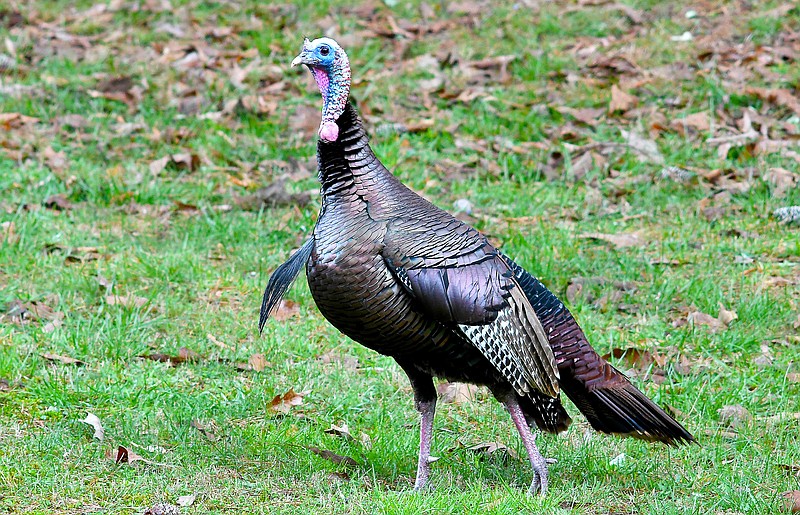It's October, and I am turkey hunting. Bo and I are sitting about halfway down the chain of mountains (hills?) between Maine and Georgia.
This area is both beautiful and terrible at the same time. Beautiful if you are driving by and looking at the fall colors, terrible if you do much walking into the guts of what really makes up this country. High ridges, hillsides of incredible cruelty in their steepness, and the occasional relatively flat place where — when you reach it — you are so relieved that you think there must really be a heaven.
The fall turkey hunter probably suffers the most of any hunter in this region because pursuing the greatest game bird in these mountains means you are almost always on the move, as the biggest challenge is simply finding them.
(READ MORE: In Appalachia, the mountain turkey is one tough bird)
Now for a quick sidebar here: We are talking about hunting turkeys in the fall in the big woods. This is not dealing with what I think of as farm turkeys, those that live in cultivated areas bordered by forest. The farm turkeys are often seen out in the open areas of pastures and harvested cornfields, and this makes them so much easier to locate, you understand.
I have absolutely nothing against chasing farm turkeys. In fact, if I am honest about it (turkey hunters are sometimes not completely honest, I must confess) I would prefer farm turkeys over mountain turkeys most any day (read: any day of the week).
Why? Well they are easier, of course, but that is enough confession time for now.
At this particular juncture, I am leaning against an ancient log and Bo is on the ground beside me being relatively compliant about lying still as he is supposed to. About an hour previous to this, Bo the brown dog hit a home run and found a sizable flock of turkeys. Bo then proceeded to do what he and his ancestors have been doing for more than a hundred years: He chased and scattered these turkeys to the four winds.
Fall turkey hunting, you see, is very different from the spring hunt for gobblers that you have heard so much about. The hardest part of the hunt is often just finding them. The gobblers, the male turkeys, are not out on a limb every morning announcing their presence with lusty gobbles (this is to attract girl turkeys). The fall flocks of turkeys are finished with all that for the time being and are more concerned with finding food every day and just surviving.
(READ MORE: Try falling for turkey hunting's other season)
A fall turkey does have one flaw in his armor in that they are organized in groups and want to get back together if separated. If the hunter can find a flock of turkeys and get them well scattered (this is what a good dog excels at), he will then find a place to hide and call from to lure turkeys into range so he can take one home for dinner.
Now all of that sounds pretty elementary and easy, and some hunters (those who usually hunt turkeys in the spring) will tell you it just too easy in the fall to flush a flock of young turkeys and call them back to you. I am here to tell you that it is in fact easy, sometimes, but one thing some of my fall hunting buddies and I have noticed in the past several years is those times are becoming more rare.
Turkeys seem to call less than back in the day; why this is, I don't know. More predators? Maybe. The coyote gets blamed for most everything in the wildlife world, as we have discussed here before. I don't think it is all on Mr. Coyote, but it makes sense if a turkey is calling on the ground and every time he does this something rushes out of brush and tries to relieve him of some tail feathers, this would tend to make turkeys less vocal on the ground.
Musing on all this, Bo and I are stashed into our hiding place close to where he has made these turkeys fly. Twice I think I have heard the faint yelp of a turkey trying to get back with his kin.
I sit and think about what we are doing and have some satisfaction how we are doing a type of hunting that has a long tradition (much older than the spring hunt) but has greatly decreased in popularity. This type of turkey hunting will never be as popular as the spring hunt, and really, I don't want it to be. But I do hope the fall season stays on the board so those of us who have an old sentimental connection to it will always be able to walk down that trail.
For the moment, Bo settles down and is lying quietly on the dry leaves. I may even hear a slight snore.
Now, though, I hear the plaintive call of a turkey for sure, and things will soon get lively.
"Guns & Cornbread" is written by Larry Case, who lives in Fayette County, W.Va. You can write to him at larryocase3@gmail.com.
